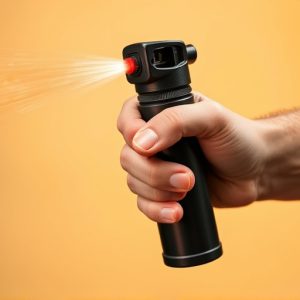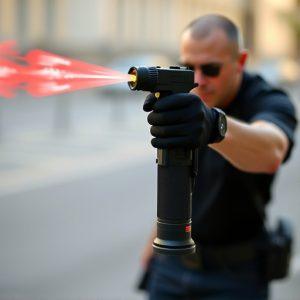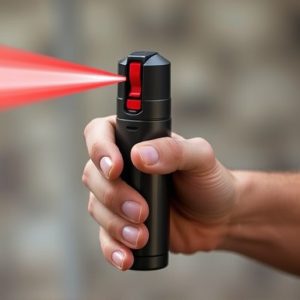Tactical Pepper Spray: Effective Deployment & Safety Guide
Tactical pepper spray, leveraging capsaicin from chili peppers, offers a powerful non-lethal defense…….
Tactical pepper spray, leveraging capsaicin from chili peppers, offers a powerful non-lethal defense mechanism. It temporarily disables targets through eye and mucous membrane irritation, with deployment methods ranging from aerosol cans to specialized clothing treatments. Effective use requires precise targeting, strategic spraying, and proper training. Safety and legality are paramount; understanding risks, local regulations, and consulting legal experts before use is crucial for responsible tactical pepper spray application.
“Unleashing a powerful deterrent in law enforcement and self-defense, capsaicin inflammatory agent spray, commonly known as pepper spray, has revolutionized non-lethal force. This article delves into the science behind capsaicin’s inflammatory properties and its role as a tactical pepper spray deployment method. We explore effective tactics for optimal results, crucial safety measures, and legal considerations, providing an all-encompassing guide to understanding and utilizing this game-changing personal defense tool.”
- Understanding Capsaicin and Its Inflammatory Properties
- Tactical Pepper Spray: A Non-Lethal Deterrent
- Effective Deployment Techniques for Optimal Results
- Safety Measures and Legal Considerations in Using Pepper Spray
Understanding Capsaicin and Its Inflammatory Properties
Capsaicin, the active ingredient in chili peppers, is a powerful compound known for its inflammatory properties. When deployed as a tactical pepper spray, it acts as an effective deterrent by exploiting our bodies’ natural responses to pain and heat. Capsaicin irritates nerve endings, leading to a burning sensation and temporary numbness, which can disable an attacker long enough for the user to escape or seek help.
Understanding how capsaicin interacts with our physiology is key to appreciating its utility in self-defense scenarios. The compound disrupts the transmission of pain signals, making it a valuable tool for personal safety. Tactical pepper spray deployment methods vary, but they all aim to maximize the impact of this natural agent. From aerosol cans to specialized devices designed for specific combat or law enforcement needs, these tools leverage capsaicin’s potent inflammatory properties to provide a non-lethal yet powerful defense mechanism.
Tactical Pepper Spray: A Non-Lethal Deterrent
Tactical pepper spray is a non-lethal deterrent that has proven its worth in various security and law enforcement scenarios. Its primary active ingredient, capsaicin, is a natural compound derived from chili peppers, known for its intense irritation to mucous membranes and the eyes. When deployed, this powerful agent creates a temporary but debilitating effect, providing crucial time for response teams or individuals to retreat or subdue potential threats.
Effective tactical pepper spray deployment methods include aerosol cans, handheld dispensers, and even specialized clothing treatments. The choice of method depends on the specific application—from close-quarters combat to crowd control and personal protection. Aerosol sprays offer a broad range of coverage, while handheld devices provide more precise targeting. Each approach ensures individuals can quickly respond to high-risk situations, making tactical pepper spray a versatile and reliable tool in modern security protocols.
Effective Deployment Techniques for Optimal Results
For optimal results with capsaicin inflammatory agent deterrent spray, understanding and employing effective tactical deployment methods are key. One of the most crucial techniques involves aiming for the eyes and face, as capsaicin is highly sensitive to the nervous system in these areas, causing immediate disorientation and temporary blindness. This direct approach significantly enhances deterrence, especially in close-quarters encounters.
Additionally, a strategic spraying pattern should be maintained, focusing on open spaces such as shoulders, chest, and legs. These areas provide maximum surface area exposure for the capsaicin to come into contact with the skin and respiratory system, ensuring a thorough and effective response. Training in proper deployment methods is essential; practicing realistic scenarios can greatly improve an individual’s ability to use tactical pepper spray as a reliable deterrent during high-stress situations.
Safety Measures and Legal Considerations in Using Pepper Spray
When considering tactical pepper spray deployment methods, safety measures and legal considerations are paramount. It’s crucial to understand that pepper spray is a powerful inflammatory agent designed to temporarily incapacitate and deter aggressors, but its use carries potential risks. Users must be trained in proper handling and application techniques to avoid accidental exposure or misuse, which can lead to adverse health effects.
Legal frameworks regarding pepper spray vary by region, so it’s essential for individuals and law enforcement agencies alike to stay informed about local regulations. Permitted deployment methods, age restrictions, and storage guidelines differ widely, necessitating a thorough understanding of one’s rights and responsibilities. Always consult with legal experts or local authorities before acquiring or employing tactical pepper spray as a deterrent.
Capsaicin, the active ingredient in tactical pepper spray, offers a powerful non-lethal deterrent option for self-defense and law enforcement. By understanding its inflammatory properties and implementing effective deployment techniques, users can maximize its effectiveness while adhering to safety measures and legal considerations. Exploring various deployment methods ensures individuals are prepared in high-stress situations, making tactical pepper spray a valuable tool for personal safety and public security alike.


